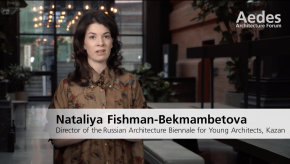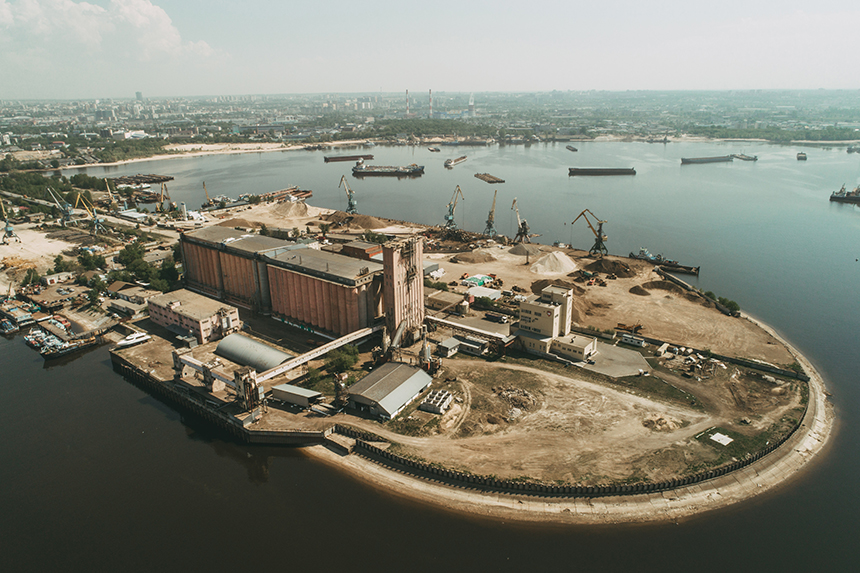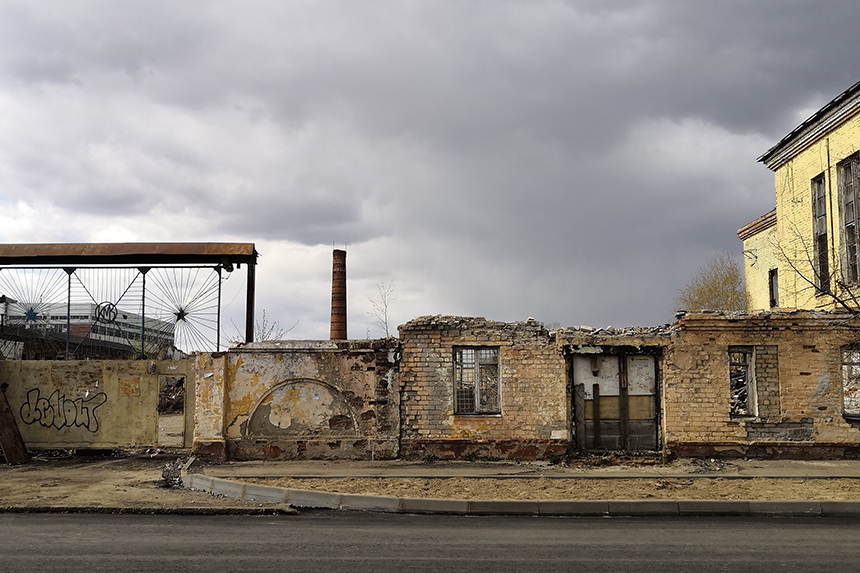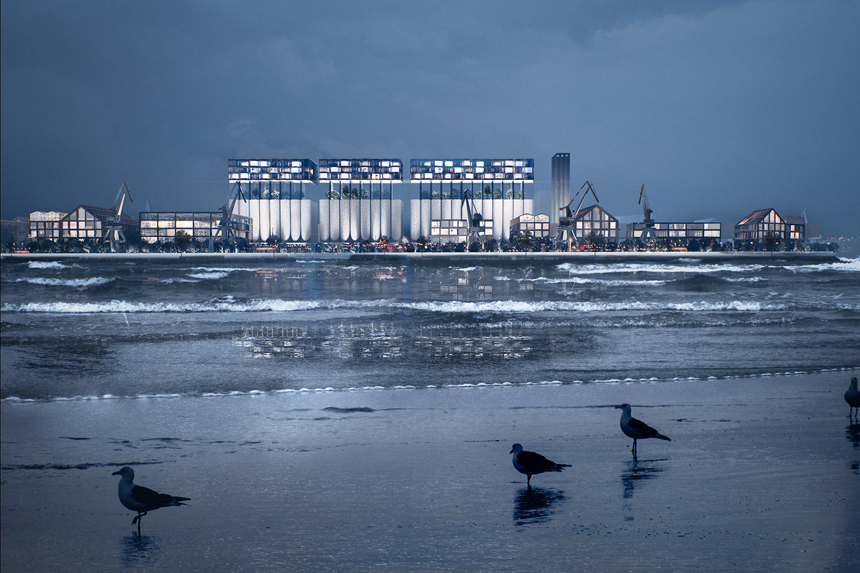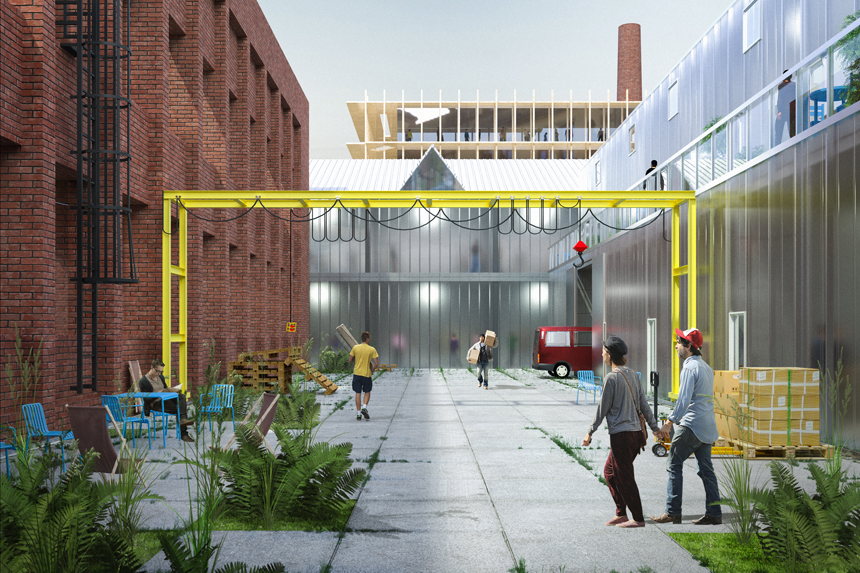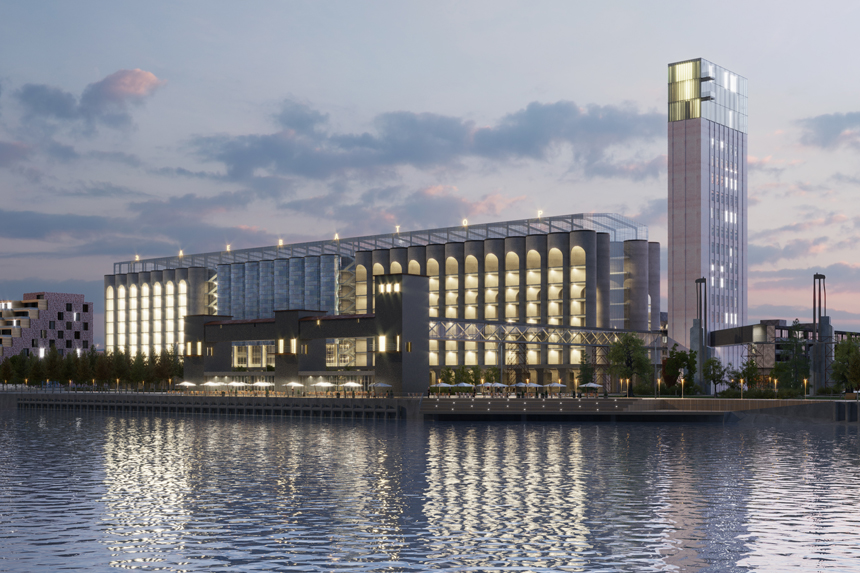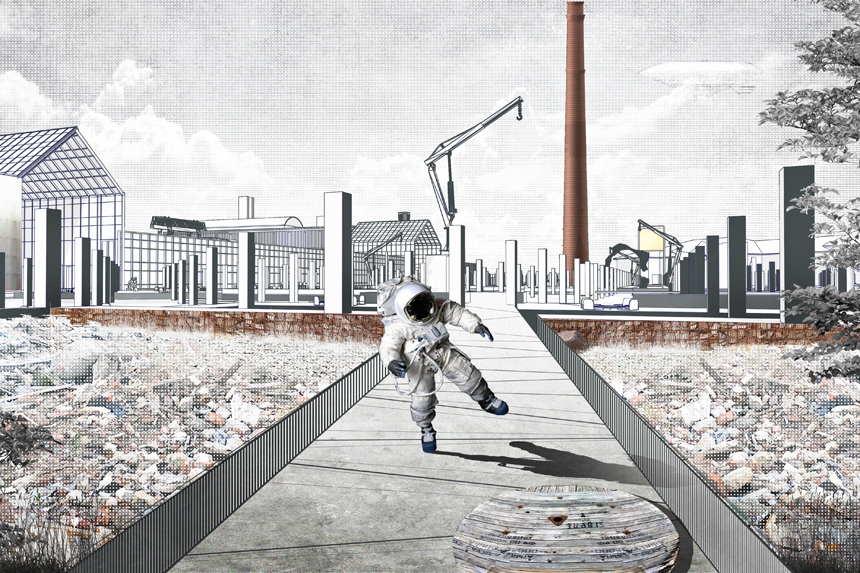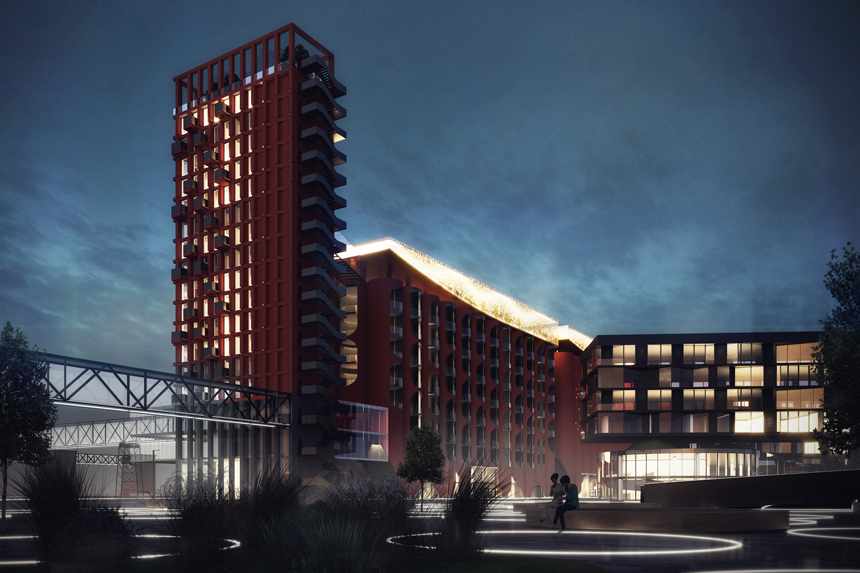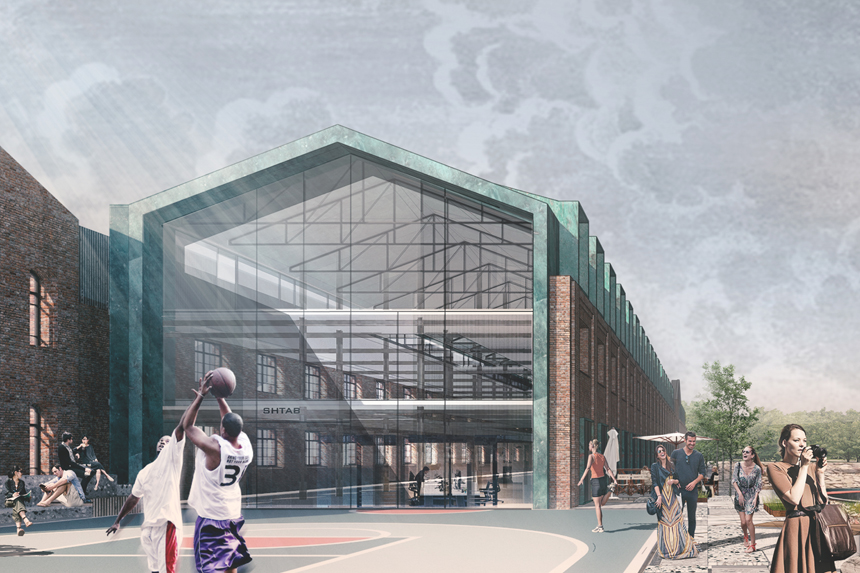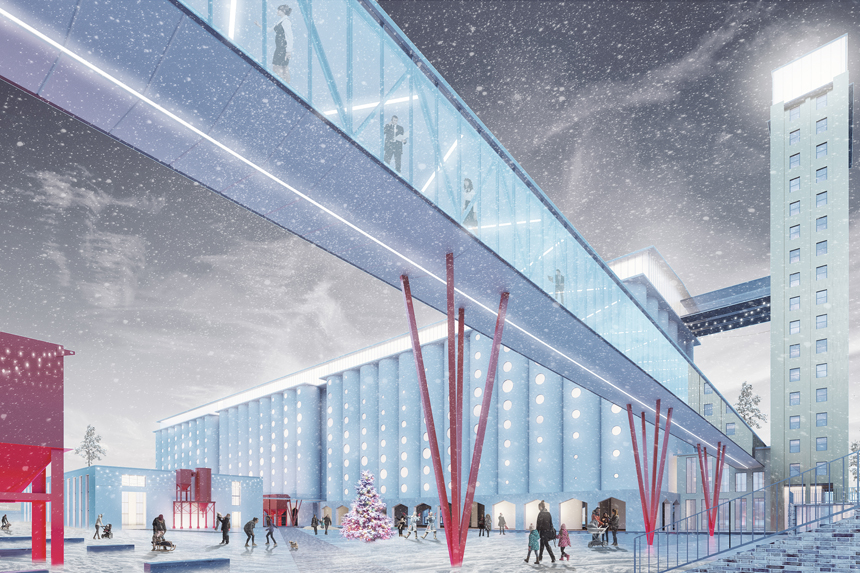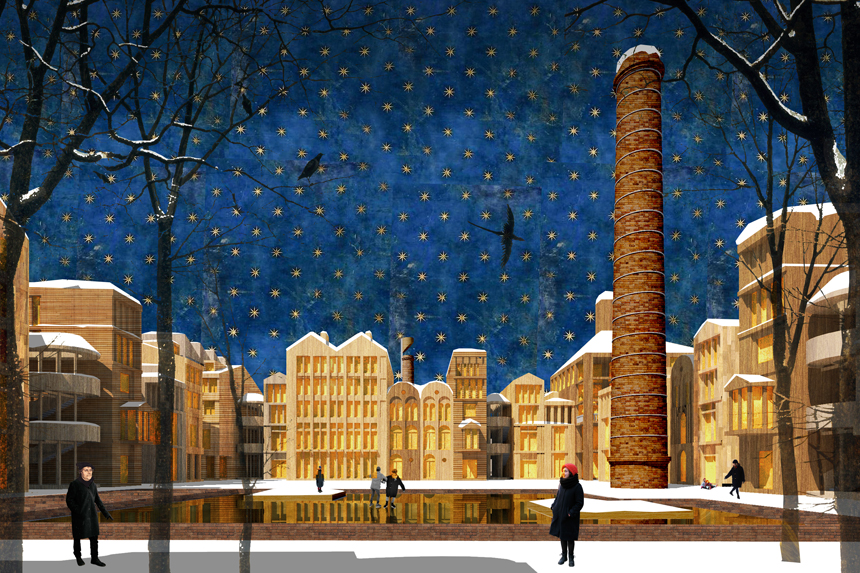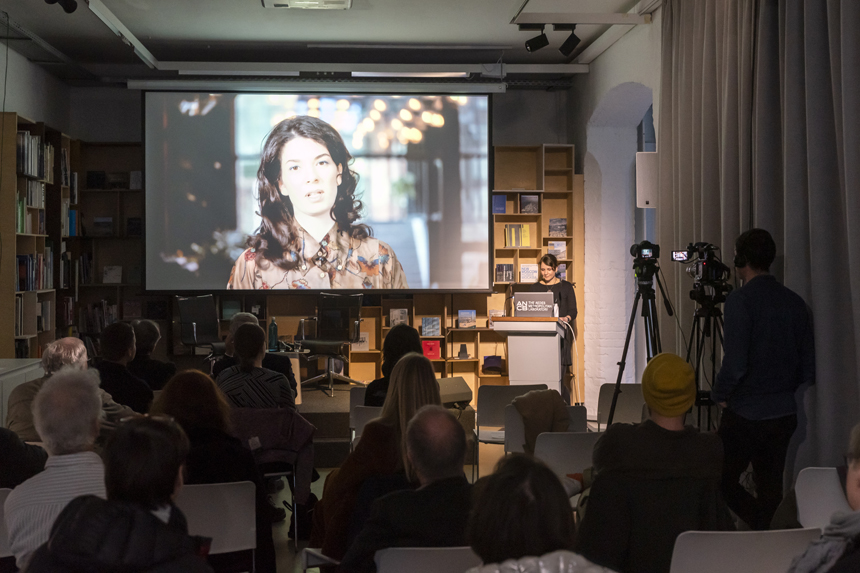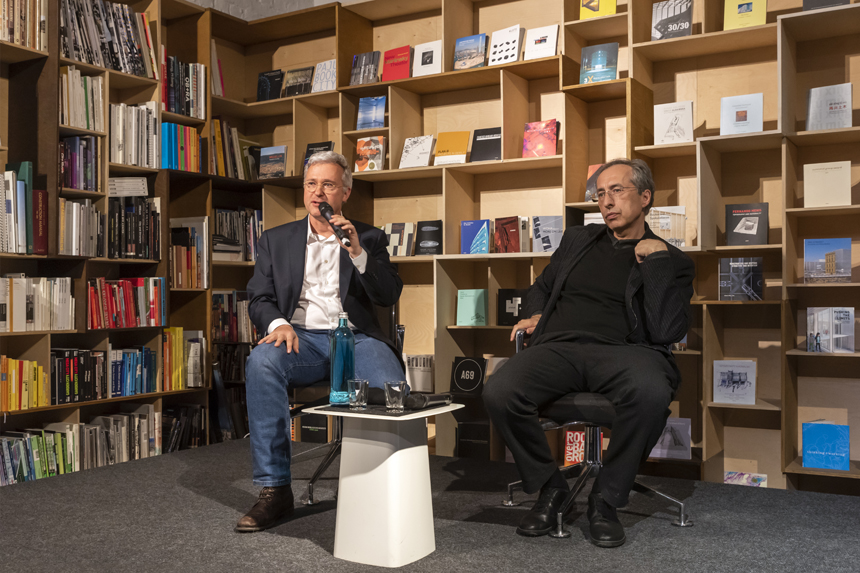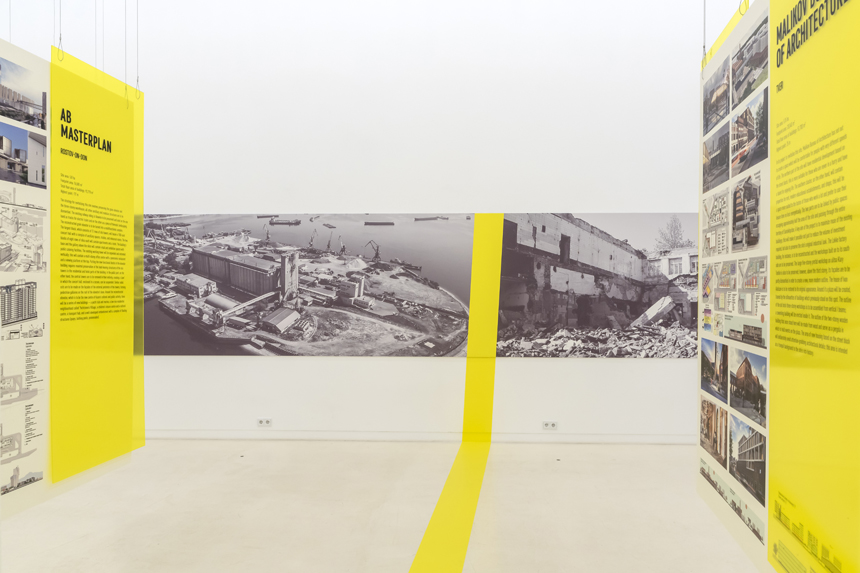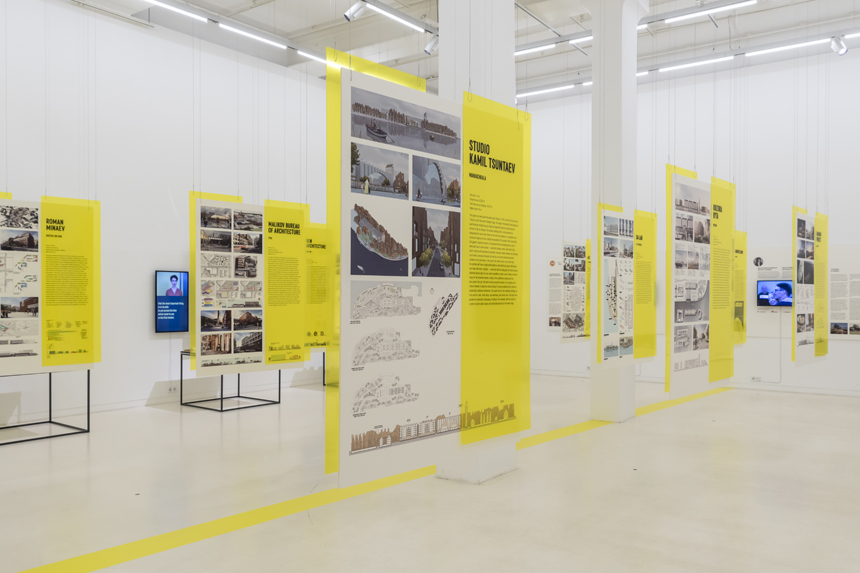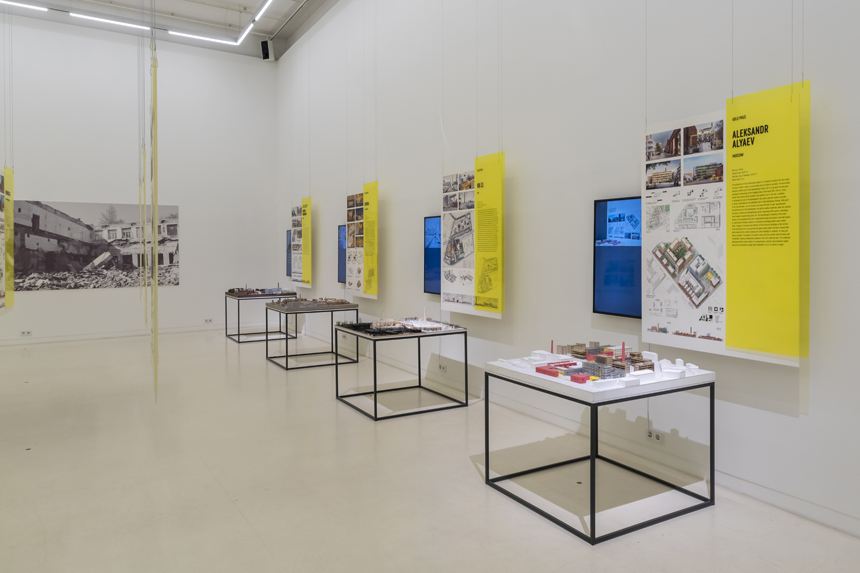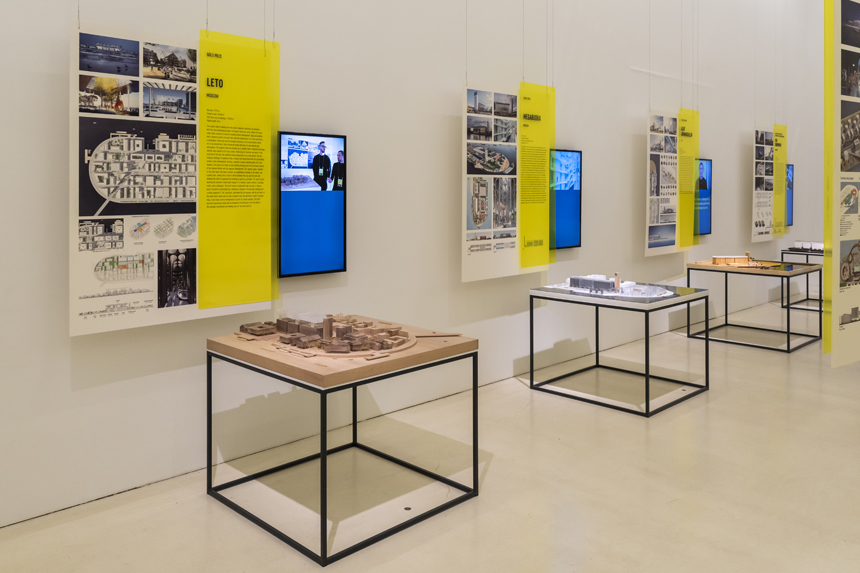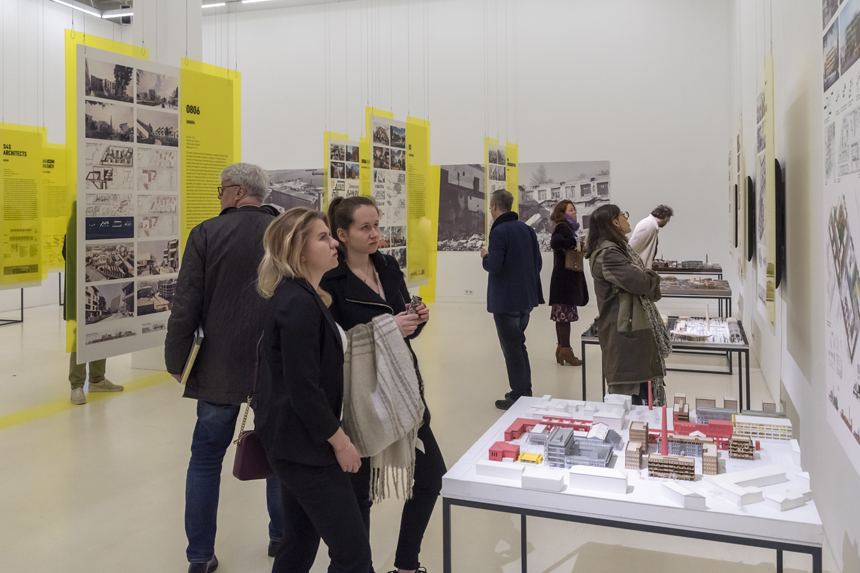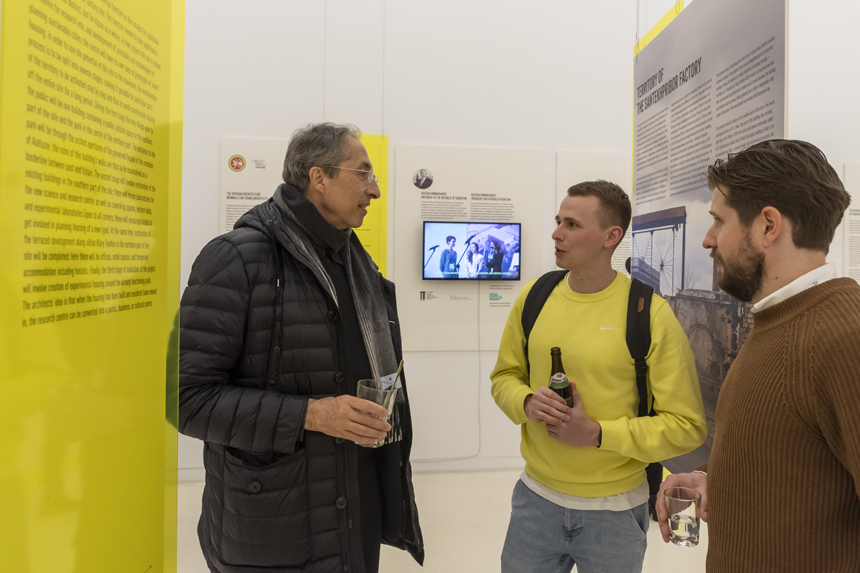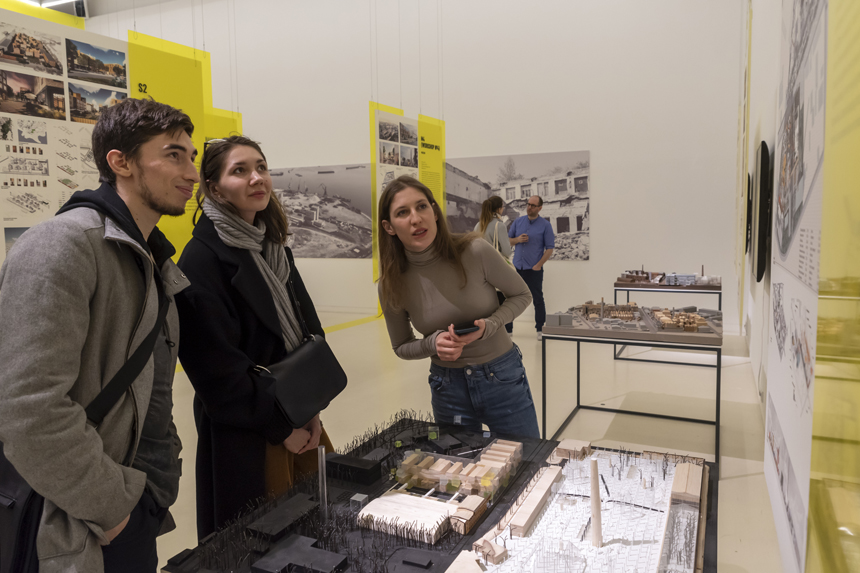Video Guided Exhibiton Tour ►
It is the only biennale worldwide dedicated to the support of young architects: The „Russian Architecture Biennale for Young Architects“ was founded by the Ministry of Housing and Communal Services of the Russian Federation and the Government of the Republic of Tatarstan in 2017. The biennale takes place in Innopolis, a young and dynamic city in Tatarstan. Its participants are Russian architects under 35 years of age which were selected from a large number of applicants. The curator and jury chairman is Sergei Tchoban, head of SPEECH (Russia) and Tchoban Voss Architekten (Germany), as well as the winner of the European Prize for Architecture 2018. The biennale’s director is Nataliya Fishman-Bekmambetova, aide to the President of Tatarstan. Winners of the biennale receive real commissions for projects in Tatarstan and are then members of the jury for the following competition, alongside leading international experts.
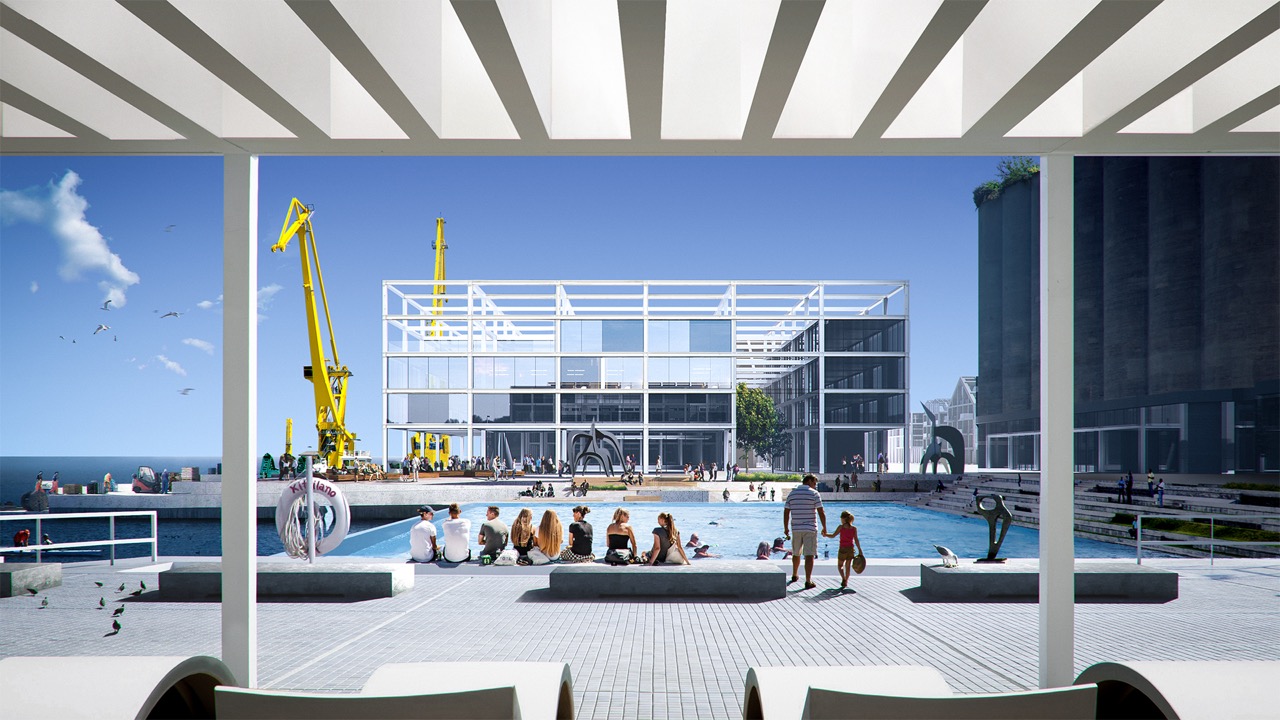
Port's Grain Elevator site, Gold Prize: LETO (Pavel Kultyshev, Dmitrii Prikhodko), Moscow. © The Institute for Urban Development of the Republic of Tatarstan
The Second Russian Architecture Biennale for Young Architects was held from 24-26 October, 2019 on the theme of the revitalisation of industrial sites. The 30 competitors were selected from more than 730 young Russian applicants. They developed proposals for a systematic redevelopment of two sites in Tatarstan’s capital, Kazan; on the area of a grain elevator in the port and the former Santekhpribor Factory. Both territories have an area of approximately five hectares and are currently inaccessible to the public. They contain remnants of industrial facilities alongside ruins of disused buildings. The brief required the competitors to propose scenarios for a new use of one of the two industrial sites (lots were drawn in order to determine which finalists would work with which site). The participants were asked to preserve and emphasise the site’s status as historical landscape and to devise and justify new functions capable of guaranteeing an economically profitable and socially responsible transformation of the site in the long term.
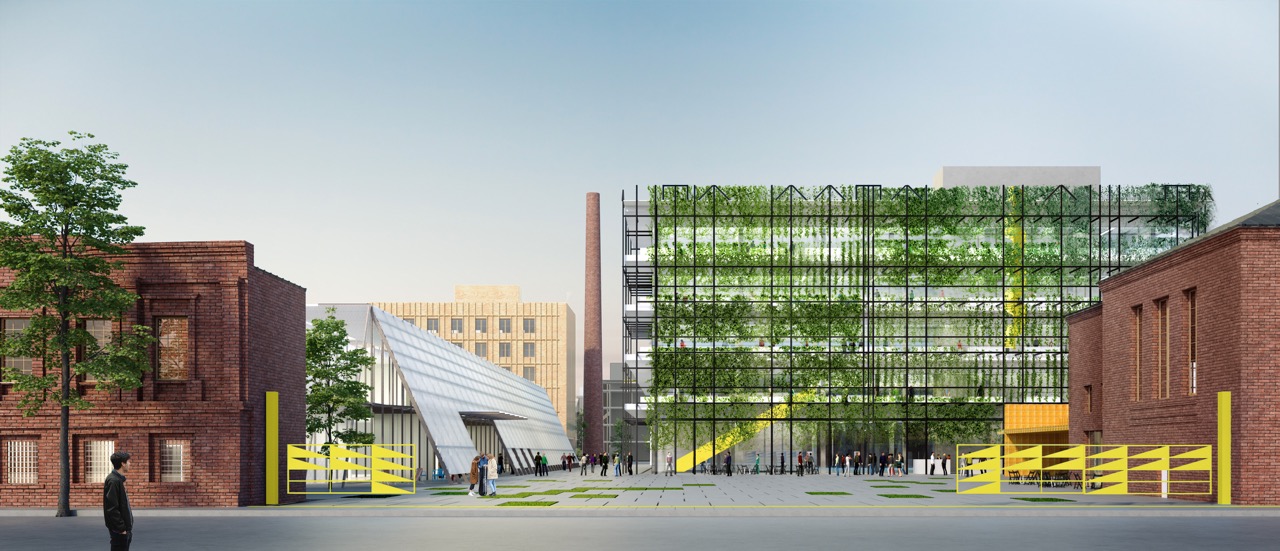
Santekhpribor Factory site, Gold Prize: Alexandr Alyaev, Moscow. © The Institute for Urban Development of the Republic of Tatarstan
The chosen theme is of high relevance: today the necessity of reconceiving former factories and manufactories confronts almost every city in Russia, as well as urban regions worldwide. The strategic transformation of former industrial zones and their buildings is a major factor which determines the appearance and quality of life of a metropolis. Although the projects developed by the competitors of the Second Russian Architecture Biennale for Young Architects will not necessarily be realised exactly as conceived, they have created an extraordinarily diverse repertoire of ideas for revitalising industrial spaces – ideas, which can subsequently be employed equally in Kazan or any other city in Russia.
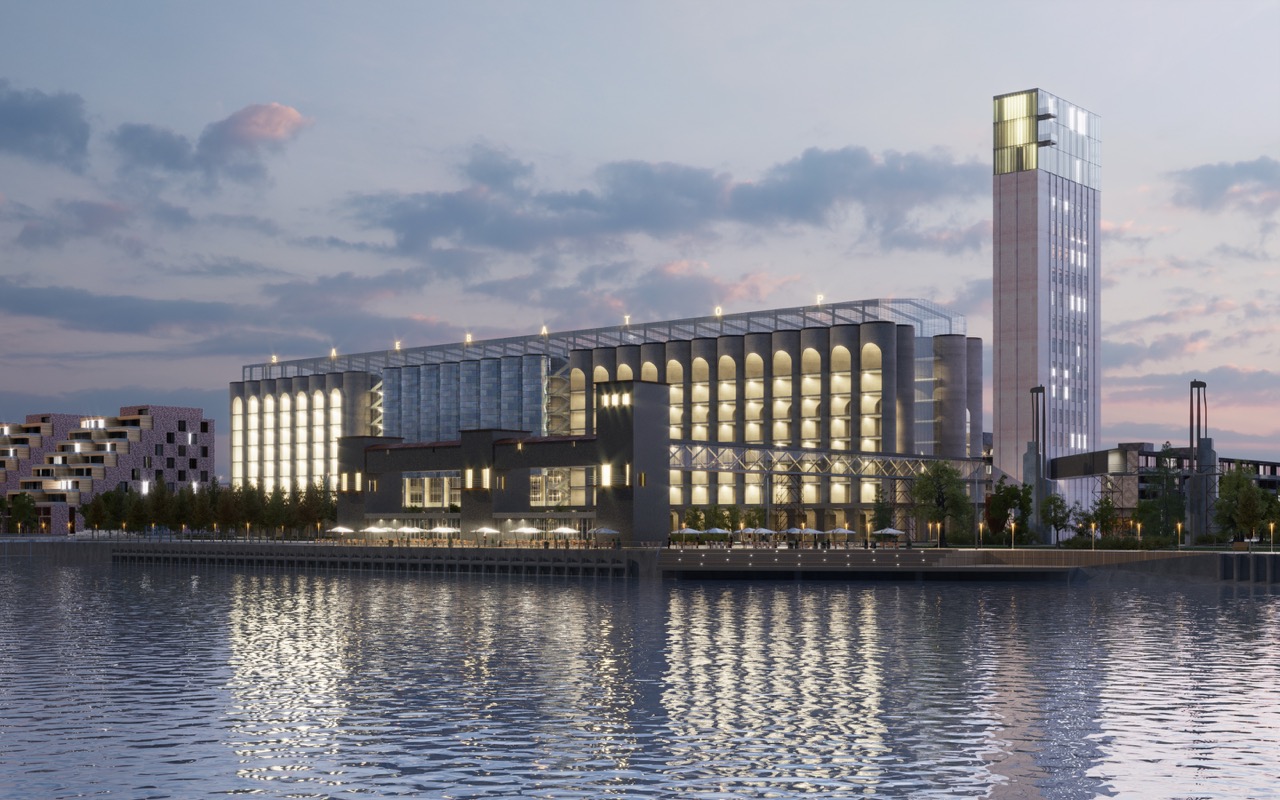
Port's Grain Elevator site, Silver Prize: Megabudka, Moscow. © The Institute for Urban Development of the Republic of Tatarstan
From 14 March to 29 April, Aedes Architecture Forum will host an exhibition presenting the 30 selected projects of the Second Russian Architecture Biennale for Young Architects. The winning proposals will be represented by models, as well as presentation boards, accompanied by video interviews in which the young architects speak about their projects and the importance of the competition for their professional careers.
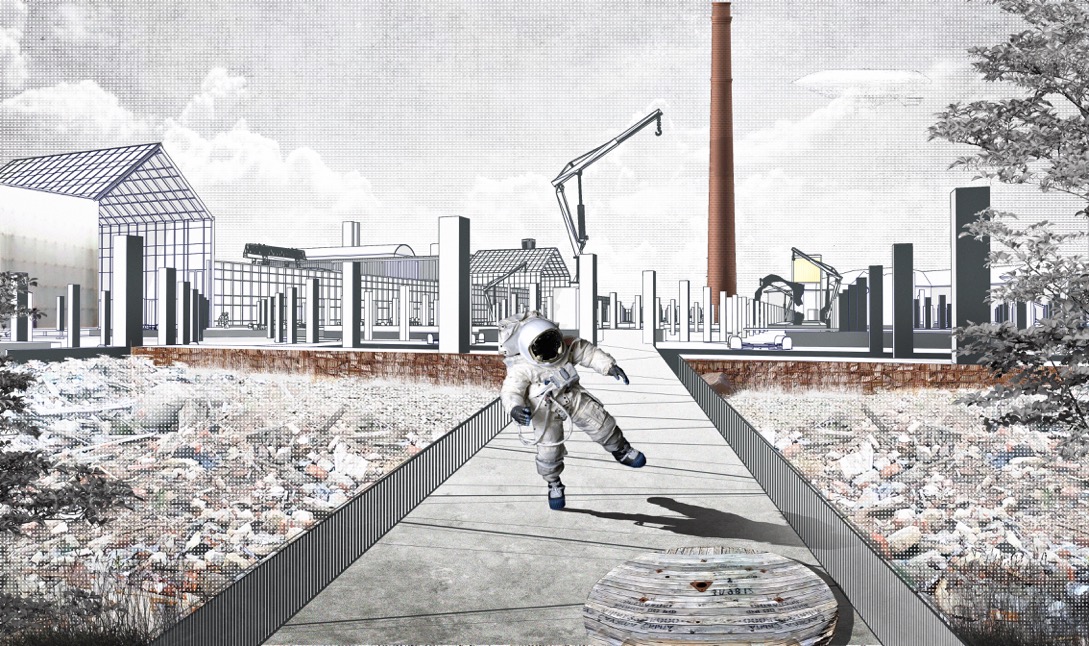
Santekhpribor Factory site, Silver Prize: KB 11, Ufa. © The Institute for Urban Development of the Republic of Tatarstan
A separate section within the exhibition, which was realised entirely by the Institute for Urban Development of the Republic of Tatarstan, will look at the role of Tatarstan both as a region of the Russian Federation and as the biennale’s initiator and venue. This region has implemented unique projects for the public spaces and socially important structures, including those designed by young architects. In 2019, the Republic of Tatarstan’s Public Spaces Development Programme became the first project in Russia to receive the Aga Khan Award for Architecture.
Territory of the Santekhpribor Factory, Kazan
Gold Prize
Aleksandr Alyaev
Moscow
Site area: 4.95 ha
Footprint area: 18,277 m²
Total floor area: 52,107 m²
Highest point: 24 m
The principal aim of this revitalisation project is to radically transform the site’s urban structure in order to make it as permeable and accessible as possible. The excessively extensive northern part of the Santekhpribor factory site is to be split into two parts matching the dimensions of the standard urban street block (100 x 150 m.); three similar street blocks will be created in the southern part of the site. In addition to softening the scale of the development, this layout approach makes it possible to create a new vehicular and pedestrian axis in Admiralteyskaya Sloboda. Both parts of the site will have a mix of functions, but each will have its own ‘specialization’: the northern part of the Santekhpribor site will be mainly residential, while the southern will have a creative and manufacturing cluster comprising office spaces, workshops, small modern manufacturing units, etc. The morphological similarity of the street blocks is to be emphasized by their compositional design and layouts: each will consist of small blocks forming a system of consistently developing public spaces which differ in degree of seclusion and intimacy. All the historical buildings on the territory of the old factory are to be preserved and given mainly public functions. Around them buffer zones will be created, allowing the listed buildings to ‘resonate’ as freely and fully as possible. The design of the public spaces will also include street furniture and installations making metaphorical allusions to the site’s industrial past. The residential development will mostly consist of 4-storey houses; only the most important spatial axes are to be marked out using taller landmarks of up to 24 metres in height.

Silver Prize
KB 11
Ufa
Site area: 4.9 ha
Footprint area: 15,541 m²
Total floor area: 31,548 m²
Highest point: 23 m
The proposal by KB 11 looks to culture, not manufacturing and industry as the motor for development of the territory of the Santekhpribor factory. Previously monofunctional, this site will now have a wide range of different functions, spurring transformation of the extremely rationalistic freestanding volumes into flexible urban structures. The northern part of the site is treated as a mainly public space bounded by the existing walls of the industrial buildings and by temporary pavilions. Here an extremely lively terrain is to be created by conserving the historical layer of manufacturing waste; the latter will be deliberately left on the site in memory of its past and of the tragic decline with which we are confronted here today. The boundaries of the square are to be denoted with columns and decorative areas of water whose configuration will repeat the outlines of the buildings that once stood here. Between these elements the existing well-worn path is to be upgraded; this will be backed up by a system of bridges and passageways. A kind of city-utopia will be created in which people will undergo a unique spatial experience, including through the erosion of the boundaries between outside and inside space and between urban and domestic furniture. In order to make the ruins suitable for all-year-round use, inserts are to be created inside and between them in the form of understated glasshouses and mobile luminous volumes on vertical tracks. During the daytime the luminous structures will serve as hospitable lounge areas at ground level; in the evening they will rise above the site and provide it with illumination. Counterbalancing this space, the southern part of the site is to be treated as a concentration of striking emphases and energetic spatial forms.
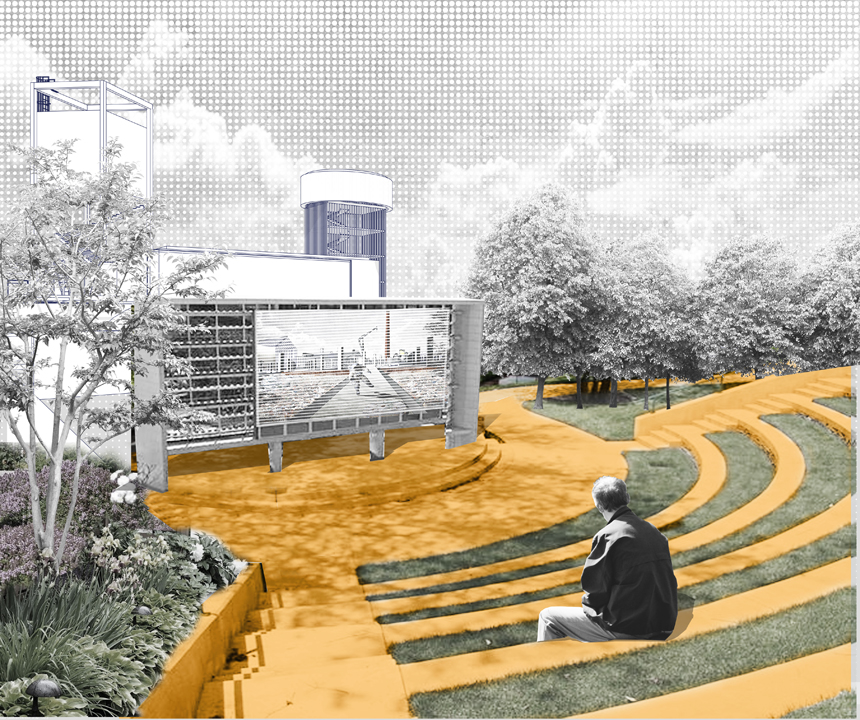
Special Mention
CHVOYA
St Petersburg
Site area: 5.6 ha
Footprint area: 17,464 m²
Total floor area: 52,812 m²
Highest point: 27.4 m
This proposal for renovating the territory of the Santekhpribor factory rests on two key ideas. First, considerate and attentive treatment of the site, and, second, a realistic functional programme which fits the context. The master plan for development of the southern part of the site is based on the existing positions of the buildings, which form a series of interconnecting, but separate and truly different spaces, and likewise on the type of development in this territory, which is built up with prefabricated standardized industrial buildings. Here CHVOYA propose creating a so-called ‘light-industrial cluster’ with a prevalence of spaces for small local manufacturing enterprises that combine ‘pure’ manufacturing, warehousing, and showrooms for factory products. The creation of this manufacturing centre will provide an impulse for development of the surrounding territories, especially in the northern part of this site. The layout for the latter is based on ‘power lines’: walls which have survived from the transverse pre-Revolutionary blocks will determine the transverse routes of the streets, while the chimney of the boiler house will provide the main longitudinal axis; and this grid of coordinates will be used to design three street blocks. The existing ruins are here to be preserved and conserved, while the new street blocks are to be built directly adjacent to them. At the spot where the new development meets the house of Alafuzov the new building will stand on the boundary of the building that once existed here, revealing the latter lost volume and turning this phantom building into a garden. The same approach is to be taken to the surviving buildings along ulitsa Klary Tsetkin. This strategy makes it possible to create an extensive green buffer zone which on the one hand separates the new development from the noise of the street and on the other increases the clearly insufficient width of the pavement. In terms of function, the street blocks are housing intended for long-term rental; they include both free-standing houses and small apartment-block modules.
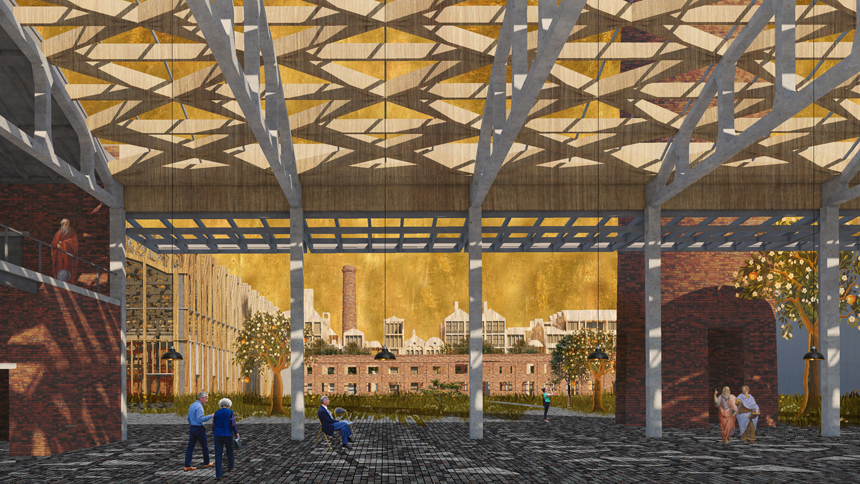
Special Prize of the Government of the Republic of Tatarstan
Kseniya Vorobieva
Moscow
Site area: 5.8 ha
Footprint area: 24,200 m²
Total floor area: 118,570 m²
Highest point: 23 m
This proposal for revitalising the industrial zone of the Santekhpribor factory is split into five stages in response both to the physical condition of the buildings and to the proposed new programme for the site, which will make it possible to fill this territory with housing as quickly as possible. The first stage is to be the creation of a headquarters for renovation of the entire Admiralteyskaya Sloboda in the old sewing workshop of the factory of the industrialist Ivan Alafuzov. This will consist of coworking spaces and small offices, conference rooms, and rooms for hearings and lectures. At the side of the building where the existing wall on the courtyard side is in a state of irreversible ruin there will be a sports area; nearby, the ‘ruin/hole’ will contain a skatepark. Between the Headquarters and the factory chimney a plaza will be created: in order to minimize expenditure on sanitizing its soil, a transparent covering will be placed on top of the existing ground. This stage will also include the creation of a restaurant and cinema in the old canteen building on the corner of Uritskogo and Malo-Moskovskaya streets, for which purpose an extra (third) storey is to be built on. The second stage will involve the creation of a coworking space in the old industrial block situated along ulitsa Klary Tsetkin, as well as extensive landscaping of the entire territory, including the creation of an amphitheatre using brick from buildings which have been dismantled. The third stage will see the addition of an office complex and a pedestrian boulevard linking Malo-Moskovskaya and Militseyskaya streets. The fourth stage will involve creation of a residential street block (arranged around three private courtyards) in the northern part of the site and a school and children’s centre (in the building which used to be the Lokke parquet factory) in the southern part. The fifth and final stage will bring the creation of a boutique hotel in what used to be the private house of Ivan Alafuzov. The proposals for the southern part of the site are rounded off by a further residential street block.
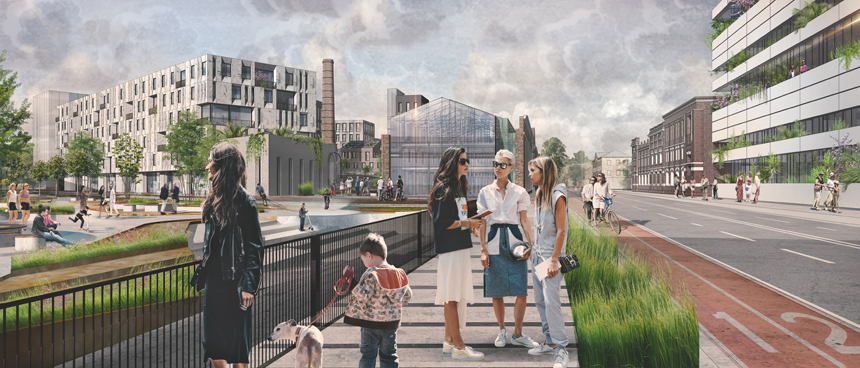
612
St Petersburg
Site area: 5.63 ha
Footprint area: 1.85 ha
Total floor area: 65,500 m²
Highest point: 30 m
The project sees the revitalised Santekhpribor site as a ‘generator of diversity’. New buildings, as different as possible in terms of both function and architecture, will form a close symbiosis with the industrial structures which are to be preserved on the site, introducing into this part of the city an array of functions which are new to it — modern formats of housing and offices, as well as cultural and public spaces. In particular, the street front of buildings along ulitsa Klary Tsetkin will be preserved in its entirety as the most distinctive and recognizable part of this site’s architectural history. The façade of the newly listed item of cultural heritage — the house of I.I. Anafuzov — will also be carefully restored; the background to this monument will be the monolithic Klary Tsetkin Museum, a museum of political history. The new museum building will not dominate, but rather complement the preserved façade, replacing the monument’s lost volume. Ulitsa Klary Tsetkin, the street which has suggested the subject of the museum’s exhibition, is to be reconstructed, allowing more effective use of its space and bringing to life the buildings abutting the street. The public spaces which are to be developed on both parts of the site are to be interpreted as a system of interconnecting public gardens and squares, making the territory of the old factory entirely permeable to pedestrians. An additional link between the two parts of the site will be a pedestrian bridge ending at a viewing platform and a waterfall. The area of water around this aquatic attraction will symbolically point to the history of this site, where there was once a factory producing bathroom fittings.

0806
Samara
Site area: 4.9 ha
Footprint area: 22,034 m²
Total floor area: 62,800 m²
Highest point: 23.1 m
This project is based on the idea of the harmonious co-existence of different spatial and temporal strata within the confines of a single site. The carefully preserved structures on the outer edge of the territory serve as an embodiment of the link between different epochs and of longevity, while the new buildings personify the flexibility and capacity for transformation of all kinds that is characteristic of our time; the public spaces situated between them will allow the site to be activated during the very first stage of the project. The diversity of functions and types of housing is at its most concentrated in the street block around the square beside the old factory gate: here there will be a coworking space, a house containing studio apartments, an art residence, an events hall, and a universal exhibition space. At the opposite end of the street block the flow of life becomes more fluid: here there will be townhouses, public functions in the form of a hotel and a family shop, and public spaces in the form of an artificial lake with landscaped embankments. Water as an element in the layout structure plays a key role on this site: the street block which is to be created on the territory of the old factory is to be built in separate ‘parcels’ around a curving lake whose contours are intended to recall the river — that same aquatic artery along which in the distant past there sprang up first the ancient village of Bishbalta and then Kazan, which several centuries later built its Admiralty here and then in the 20th century the Santekhpribor factory. The image of water permeates the architectural and layout design of every part of this street block, including the storm-water drainage system, the decorative ponds, the modern buildings whose outlines bear an unmistakable resemblance to ships, shipping containers housing temporary services and cafés, and, finally, the decks of the public spaces.

AR ARCHITECTS
Kazan
Site area: 4.97 ha
Footprint area: 14,510 m²
Total floor area: 41,070 m²
Highest point: 23 m
AR Architects have set out to find a universal function as the catalyst for qualitative renewal of the Santekhpribor factory site. The function needed to have significance not merely for this district, but for Kazan as a whole. In their project this role is played by a centre for research into, and development of, principles and technologies for planning sustainable cities; the centre will have its own base of prototypes of ‘smart’ housing. In order to use the potential of this site to the maximum, the revitalisation process is to be split into several stages, making it possible for particular parts of the territory to be activated step by step and thus to avoid construction closing off the entire site for a long period. During the first stage the only things open to the public will be one building containing a public cultural space in the southern part of the site and the park in the centre of the northern part. The entrance to the park will be through the arched apertures of the preserved façade of the mansion of Alafuzov; the ruins of this building’s walls are thus to be reconceived as a borderline between past and future. The second stage will involve restoration of the existing buildings in the southern part of the site; these will house laboratories for the new science and research centre, as well as coworking spaces, lecture halls, and experimental laboratories (open to all comers, these will encourage locals to get involved in planning housing of a new type). At the same time, restoration of the terraced development along ulitsa Klary Tsetkin in the northern part of the site will be completed; here there will be offices, retail spaces, and temporary accommodation including hostels. Finally, the third stage of realization of the project will involve creation of experimental housing around the already functioning park. The architects’ idea is that when the housing has been built and residents have moved in, the research centre can be converted into a public, business, or cultural centre.

ARCHSLON
Moscow
Site area: 4.95 ha
Footprint area: 72,576.5 m²
Total floor area: 48,121.3 m²
Highest point: 23 m
This revitalisation project for the Santekhpribor factory aims to create a striking and expressive local urban centre with a layout formed by a system of squares, boulevards, and hills and with multidimensional architecture which interacts equally with Kazan’s history and the city’s contemporary social-cultural context. The multi-layered architectural environment of varying height will consist of separate buildings on a human scale which together form street blocks at the level of the permeable plinths containing the first storeys. A distinctive feature of the new development is to be the prevalence of white-coloured finishing materials; the white colour will highlight historical strata which are to be preserved. The mansion of I.I. Alafuzov will house museum and exhibition spaces; there will be a large exhibition hall with a glass roof on the top floor. The building at ulitsa Uritskogo 18/20 is to be reconstructed to house the administration for the entire complex, while the factory’s shop floors are to be used to create offices and a two-sided retail arcade on the ground floor; the façade overlooking ulitsa Klary Tsetkin will form a covered pedestrian alley which will add width to the existing narrow pavement. Several other factory buildings will retain their lead-bearing frameworks and be given completely new contemporary façades; these will house offices, hotels, and restaurants. The memory of the dismantled factory blocks is to be preserved in five interconnecting squares, each of which will have its own function. The natural environment, which begins at the city park situated outside this district, will pass in the form of a green carpet beneath all the architectural structures, rising as hills on the squares and streets and descending towards the main entrance zones providing access to the territory. This lively terrain will not merely tie together the spaces of the streets, squares, and building plinths to form a unified network, but also establish a unique code for the architectural environment, forming picturesque viewing points.

BUREAU ARD
Krasnodar
Site area: 4.91 ha
Footprint area: 32,700 m²
Total floor area: 147,000 m²
Highest point: 30 m
Bureau ARD proposes creating a multifunctional residential district on the site of the Santekhpribor factory. In line with the existing layout for this site, the project is split into two clusters — southern and northern. The content and status of the northern cluster may be described as ‘business class’, while the southern cluster will combine residential and office formats in the ‘comfort’ and ‘business’ classes. The complex’s social and cultural core is to be a museum of Russian industrial architecture — situated on a rapidly developing territory with structures from the 19th, 20th, and 21st centuries. The museum will not so much display ‘artefacts from the past’ as serve as a platform for interaction between society and the urban environment as the latter undergoes transformation. Another important emotional anchor for the project is the Alafuzov boutique hotel, which will be situated in the house of the same name following its careful restoration. The architecture of the new development in both clusters is inspired by the Modernist aesthetic: the factory’s two territories are interpreted as large islands/plinths dividing private land from land belonging to the city; above them rise the parallelepipeds of residential and public buildings. In order to soften the scale of this megastructure, all the new structures are to be given three-dimensionally lively façades with numerous terraces, balconies, and bay windows in a great variety of different shapes. Especially worthy of attention is the multi-tiered vegetation covering all the flat roofs in the street blocks. In order to realize this idea, the thickness of the roofs will be increased. At ground-floor level provision will be made for spaces filled with earth for planting large plants. Additionally, there will be vegetation (flowers, bushes, lawns) on the terraces of the apartments. Another special feature of the project is recycling of the remains of buildings which have been destroyed during clearing of the site: these building materials may be used as filling for building envelopes.

S2
Novosibirsk
Site area: 4.8 ha
Footprint area: 16,716.7 m²
Total floor area: 33,614.71 m²
Highest point: 20 m
Key to the philosophy of this project is the problem of recycling and re-using construction rubbish; the symbol of the revitalisation of the Santekhpribor factory site is to be the existing dramatic landscape consisting of fragments and remains of buildings from very different ages. S2 have studied the entire existing development in order to identify parts of the load-bearing structures that are suitable for re-use and then devised a design based on this ‘rigid framework’. In particular, the surviving walls of the house of Alafuzov are to be reinforced, and on the courtyard side, at a distance of 4.6 metres from them, a two-storey frame-based building for public and residential use is to be erected. The scale and proportions of the new building will match the existing scale of the destroyed building, forming simultaneously both a background for the surviving old wall and a kind of phantom of the destroyed building. At the intersection of Klary Tsetkin and Malo-Moskovskaya streets, this volume is to be linked to a viewing platform by a bridge/terrace. The street front of the existing development along ulitsa Klary Tsetkin is likewise to be preserved to the fullest possible extent, with the addition of modern insertions where necessary. These buildings will contain a concentration of public functions — including co-working spaces, fitness centres, cafés, and small shops — tailored to suit their locations. At the intersection of Malo-Moskovskaya and Uritskogo streets there will be a new four-storey hotel building; between this and the house of Alafuzov will be the district’s central square. The internal structure of the street block will consist of a 15 x 15 metres layout grid incorporating low-rise residential buildings and interconnecting landscaped courtyards.

SON ARCHITECTURE
Moscow
Site area: 4.1 ha
Footprint area: 14,700 m²
Total floor area: 77,860 m²
Highest point: 21.5 m
This project to revitalise the Santekhpribor factory sets out, above all, to preserve the memory of the site’s historical past. All the new buildings are to be situated within the boundaries of old foundations, partially using the latter as a structural support and in many cases creating inside them public and private spaces below ground level. The architecture of the new buildings will have lower levels executed using traditional brickwork with insertions of the old brick that is left behind following demolition of buildings. The perimeter walls of the top storeys will consist mainly of surviving blocks from buildings erected at a later date and of glass blocks as the most authentic material for an industrial building from the 1960s and 70s. The second crucial idea for this project is a symbiosis of architecture and nature. The ruined buildings which are to be preserved on the site are to be planted with grasses and bushes, forming a picturesque composition. The diverse paving of the inner squares and streets will use construction debris collected on the site. In terms of function, the northern part of the site will be divided into three parts: in addition to street blocks of urban villas and apartment houses, there will be a public zone containing a landscaped recreational area and a pond, a contemporary-art gallery, and a hotel. The principal feature and symbol of this district will be the factory chimney with its upper part rebuilt from glass bricks. On the perimeter of the site the old renovated buildings will have ground floors mainly occupied by restaurants and shops and second storeys fitted out with offices and coworking spaces. On the southern part of the site an industrial building from the 1970s will be turned into a shopping centre with a green atrium overlooking the interior of the street block, while the old factory buildings along ulitsa Klary Tsetkin will contain a fine-foods market. Behind the shopping centre a public garden will be created above a three-level underground car park.

URBANSCALE
Veliky Novgorod/Moscow
Site area: 5 ha
Footprint area: 14,100 m²
Total floor area: 104,050 m²
Highest point: 27 m
This project for revitalising the territory of the Santekhpribor factory proposes preserving not just the historical buildings, but also later Soviet structures which are likewise an important part of the history of this site. The architectural design of the façades of the new buildings and of the landscaping is based on patterns which are transformations of motifs taken from the surviving architecture and of distinctive features of this industrial territory as a whole. For instance, the plate-glass windows of the coworking units are a metaphorical allusion to the standardized blocks of the factory’s concrete fence. This design code makes it possible to preserve the genius loci, while the ornamentation helps the project fit in with the overall context of the city of Kazan. Along ulitsa Malo-Moskovskaya there will be residential blocks with public zones on their ground floors. The buildings will stand back from the street edge and the street’s cross-section has been widened so as to preserve all existing large trees while also accommodating a new pedestrian zone and a parallel thoroughfare with car-parking spaces for visitors. The courtyard part of the buildings will consist of a plinth of complex shape. On the roof of the plinth are children’s play areas and gardens; this makes it possible to free up space at ground level to accommodate a sculptural graffiti wall passing all the way through the complex’s inner territory. The central counterpoint of the development in the northern part of the factory site will be the preserved boiler-house chimney and a block housing a coworking space; the latter will combine residential capsules with spaces for work and recreation. The nearby mansion of Alafuzov will be restored and adapted for use as a School of Arts. In the southern part of the site the existing factory blocks will be reconstructed to create a large educational complex incorporating retail and office spaces.

MALIKOV BUREAU OF ARCHITECTURE
Tver
Site area: 5.15 ha
Footprint area: 20,040 m²
Total floor area: 51,700 m²
Highest point: 25 m
In its project to revitalise this site, Malikov Bureau of Architecture has set out to create a space which will be comfortable for people with very different speeds of life. The northern part of the site will have residential development based on the street block; this is more suitable for those who are never in a hurry and have a talent for enjoying life. The southern cluster, on the other hand, will contain properties for rent, modern educational establishments, and shops; this will be a space more suited to the tastes of those who work a lot and prefer to use their leisure time no less energetically. The two parts are to be linked by public spaces occupying approximately half the area of the site and passing through the entire territory of Santekhpribor. A key aim of the project is to maximize reuse of the existing buildings; this will make it possible not just to reduce the volume of investment required, but also to preserve the site’s original industrial look. The Lokke factory building, for instance, is to be reconstructed and the workshops built on to its south side are to be preserved. The large five-storey prefab workshop on ulitsa Klary Tsetkin is also to be preserved; however, above the third storey, its façades are to be partly dismantled in order to create a new, more modern outline. The house of Ivan Alafuzov is to be restored to its original appearance. Around it a plaza will be created, framed by the silhouettes of buildings which previously stood on this spot. The outline of the old brick three-storey workshops is to be assembled from vertical I beams; a coworking building will be erected inside it. The outline of the two-storey wooden building that once stood here will be made from wood and serve as a pergola in which to hold events on the plaza. The area of new housing based on the street block will deliberately avoid attention-grabbing architectural details; this area is intended as a tranquil background to the site’s rich history.
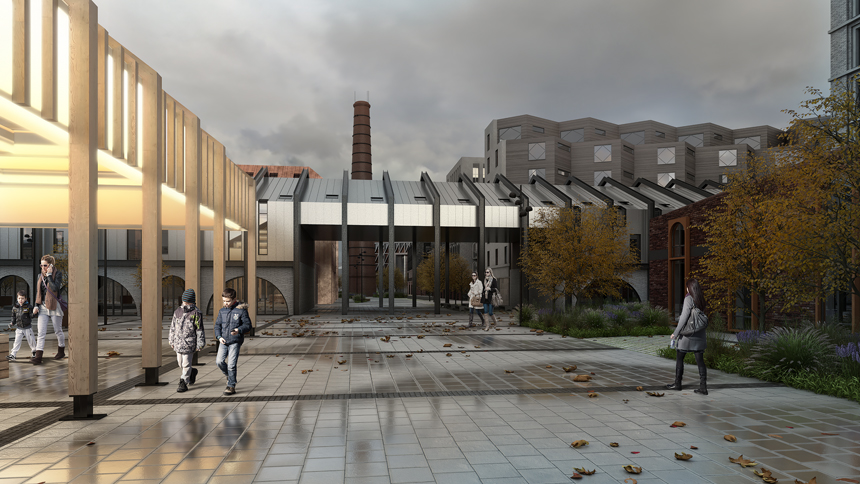
M4 (WORKSHOP №4)
Moscow
Site area: 5.57 ha
Footprint area: 19,310 m²
Total floor area: 74,637 m²
Highest point: 23 m
The proposed layout of this site is based on the visual axes linking it with Kazan’s principal historical landmarks — the Makarievskaya Church, the Zilantov Monastery, and the Kazan Kremlin. The main axis passing through the entire territory of the old factory from north to south is called the ‘axis of impressions’, and indeed it threads together the architectural and layout features which are most interesting from the spatial and visual points of view. The first point on the axis will be the so-called ‘Ruin’, which is the internal courtyard of the northern part of the site and will be the principal public space of the renovated territory. From east to west this space will be cut in two by an ‘arrow’ in the form of a ramp descending from street level on ulitsa Uritskogo to the level of the basement storey, where a museum space will be situated beneath the district’s high-rise feature — the factory chimney, which is to be preserved. The spatial design of the ramp highlights the foundations of buildings which have existed here at different times. The chimney itself is to become a viewing tower which can be ascended in order to survey the grounds of the old factory and the whole of Kazan’s Admiralteskaya Sloboda from above. The next stop on the route will be the glazed volume of the atrium, which will conserve under a translucent roof surviving parts of the factory’s historical façade. Another point of attraction will be the building which used to be the Lokke factory, a structure which symbolizes the transition from the factory architecture of the end of the 19th century to the industrial modernism of the 20th century. This transitional character explains why one corner of the building will be demonstratively slanted, while the building’s other block will gradually ‘dissolve’, turning from brick into glass. The final point on this axis is to be an apartment block dissected by a glass arch; this structure will use expressive contemporary architecture to explore motifs taken from historical factory buildings.

ROMAN MINAEV
Rostov-on-Don
Site area: 5.03 ha
Footprint area: 19,930 m²
Total floor area: 83,800 m²
Highest point: 23 m
This project involves preserving most of this site’s historical structure while combining three types of functional zone (residential, retail/cultural, and business). The northern part of the site is interpreted as a perimetral residential street block with an internal pedestrian street containing shops and cafés, an exhibition gallery, and a museum of industry. The latter will be created in the house of I.I. Alafuzov, which is to be converted for contemporary use by conserving this building’s surviving original parts and placing in the courtyard a new volume containing an exhibition hall; the latter is to be separated from the mansion of Alafuzov by a glazed atrium space. To the north, a reconstructed building with a new wing will contain an educational centre. And, finally, the factory chimney will be preserved; around it will be built a public centre whose façades of red brick will serve as a modern frame for the surviving industrial landmark. The residential development will consist mainly of sectional and gallery-type buildings, each of which will contain two-level apartments with exits onto a useable roof. The ground floors of the buildings on the external perimeter of the street block are to contain spaces for renting out, while facing the internal courtyard there will be apartments with separate entrances and small gardens. The southern part of the site is to be a business cluster with additional public functions, temporary housing, and a hotel. Office spaces are to be housed in reconstructed and new buildings, which are to be linked by two diagonal bridges that will become the district’s most recognizable feature. Some of the existing industrial buildings are to be transformed into external spaces, while all the new buildings are to be given generous internal courtyards. Together, this will help create a more comfortable environment, adapt the scale of the buildings to the territory’s new proportions, and increase the area of vegetation on this territory.

Territory of the Grain Elevator in Kazan’s Port
Gold Prize
LETO (Pavel Kultyshev, Dmitrii Prikhodko)
Moscow
Site area: 17.73 ha
Footprint area: 25,450 m²
Total floor area: 117,650 m²
Highest point: 60 m
This project aims to develop the site and all adjacent territory in accordance with the urban-planning principles for Kazan’s historical centre, where the dense urban fabric consists of mid-rise multifunctional development. High permeability and a coherent system of visual links with the embankment are to be ensured by a rectangular street grid and the compact character of the street blocks which are to be erected here. Each transverse street will have its own identity and atmosphere. The project treats the elevator as a valuable item of industrial heritage and the main symbol of the local centre. Rethinking its function and place in the structure of the city, the architects have interpreted it as a new church: like the religious buildings in medieval cities, it enters into interaction with the surrounding smaller-scale development, forming a system of plazas abutting each of its four façades. Each plaza is to have its own identity deriving from the functional content of the elevator blocks and the adjacent development. The ‘aquatic plaza’, situated in the north-west, will have a market, an amphitheatre leading to the water, and a public pool, making this a kind of buffer between the city and the river and allowing the latter to approach the building as gently as possible. The ‘sports plaza’ abutting the elevator’s south-west façade is to contain a sports centre, a climbing centre, and a skatepark. The north-eastern façade will look out onto a ‘science plaza’; this will be overlooked by a mediateca situated in the elevator building and a school opposite it. The ‘city plaza’, overlooked by the museum, will be the heart of the entire local centre and its main transport hub; this will have a public-transport stop, a taxi stand, and an underground car park for private vehicles. The fifth and most spectacular plaza will be situated on the elevator’s roof and will be the principal recreational and viewing area for the entire district.

Silver Prize
Megabudka
Moscow
Site area: 6.6 ha
Footprint area: 7,000 m²
Total floor area: 26,589 m²
Highest point: 73.7 m
All buildings on the spit, with the exception of the elevator building, are to be dismantled, and on the spit’s perimeter a continuous embankment, 50 metres wide, with vegetation, a cycle path, and a chain of entertainments and public functions (cafés, restaurants and bars, sports areas, playgrounds, recreational areas) will be created. This linear park will be echoed by a large semi-circular park on the promontory of the spit. Since clearing the water of the effects of the operation of the freight port will inevitably be a time-consuming process, Megabudka proposes for the purpose of summer recreation creating a ‘dry’ beach and preserving the existing retaining wall on the spit, while providing a capacious floating pool on an old barge for swimming in. The architectural design for reconstruction of the elevator is to be entirely dictated by this building’s geometry and structural characteristics. While carefully preserving the overall brutal character of the building, its original proportions, and the circular shape of the silos, Megabudka will cut tall arched windows into all the external cylinders; the two central rows are to be removed in their entirety in order to create an atrium. The top storey of the elevator is to be glazed, yielding attractive views of the Volga and illuminating the atrium. The centre of the building will contain a multifunctional space with vaulting consisting of cylinders held in place by a metal framework. The building’s functional programme will also be emphatically diverse, including both cultural and educational institutions, commercial spaces and offices and an apartment hotel. Alongside the elevator’s long façades landscaped pedestrian plazas will be created; here the original railway tracks will be preserved as an important element of industrial identity. In memory of the tracks’ previous function a composition consisting of freight wagons will be installed; the wagons will contain a children’s playground, a lounge, a café, a recreational area, and a bookcrossing facility.
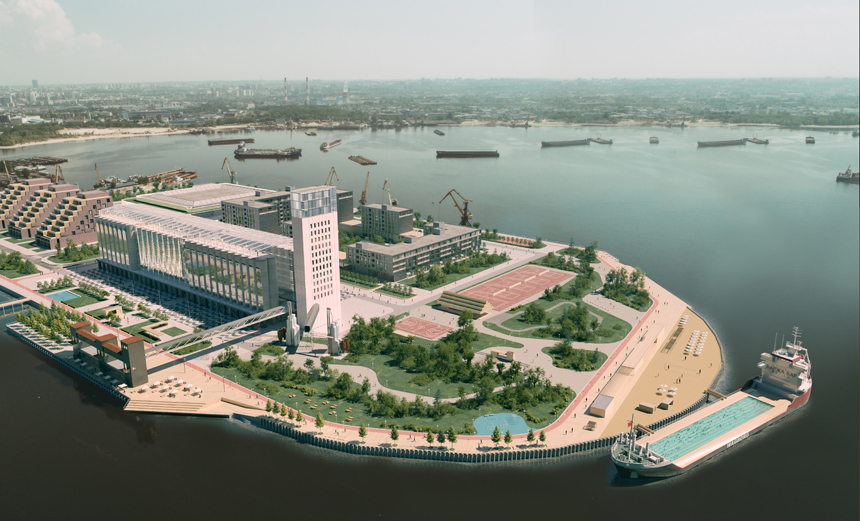
Special Mention
Azat Akhmadullin
Ufa
Site area: 5.8 ha
Footprint area: 11,988.9 m²
Total floor area: 66,625.3 m²
Highest point: 59.4 m
This project involves preserving as much as possible of the elevator while tactfully adapting it for functions that are needed today. The building’s initial function as storage for strategically important reserves of grain is to be symbolically recast in the approach adopted by the master plan for development of the adjacent territory. The base shared by all the elevator blocks becomes a spacious public zone fringed by an open gallery and containing numerous small cafés and exhibition spaces. The largest part of the elevator — the 12-row block — is to be structured around an atrium with towers that cut through the upper gallery above the silos; the towers will provide the interior with evenly distributed light. This part of the building will contain a diving pipe, a wind tunnel, and a climbing centre; the architects say that this is an interpretation of the technological processes of cleaning and drying to which the grain used to be subjected in the elevator. The history of the site will also be the subject of the Museum of Grain, which is to be situated in the central part of the elevator. Permanent housing will take the form of two urban villas, townhouses situated near the main building, and co-living spaces in the elevator gallery above the silos. The space between the elevator and the embankment is interpreted as a landscape park containing a prevalence of grain cultures. The architects’ idea is that in time this will become a golden field symbolizing the new life of the grain which was once stored in the elevator. The ships and freight trucks which were used to bring the grain here will become elements in a tourist route linking numerous play and sports areas, an amphitheatre intended for public events and concerts, and the main pedestrian square in front of the elevator itself.

Special Prize of the Ministry of Construction of the Russian Federation
Ilya Obodovsky
Simferopol
Site area: 5.8 ha
Footprint area: 17,650 m²
Total floor area: 82,960 m²
Highest point: 65.4 m
While endeavouring to preserve its overall scale and monumental appearance, Ilya Obodovsky has set out to turn the elevator building into a more user-friendly structure and one which is more open to the city. To this end, the storey below the silos will be entirely transparent, the gaps between the separate blocks will be widened, and the lower part of the building will be partly cut off in such a way as to create the feeling of a pulled-back theatre curtain while also settting up a clear visual link with the River Volga. Each separate block of silos will have a different function: museum space and media library, offices and co-working spaces, and housing and hostels. The storey above the silos will contain clubs, restaurants, and viewing platforms. The perimeter structures on this floor will be of glass and brass, in reference to the grain which was once stored here, while the façades of the elevator itself are to be of a dark claret colour. The central longitudinal axis of the site is to be turned into a boulevard; around this there will be a number of additional new buildings containing offices, housing, and multi-storey car-parking. The modern architecture of these structures will enhance the elevator’s dynamic image. The industrial zone on the spit, which is adjacent to the elevator site, is to be treated as a large public space with green plots of land with a variety of different functions, a landscaped embankment, pedestrian bridges, cycle tracks, yacht clubs, business centres, and housing. A waterfront plaza will feature a floating concert area and amphitheatres with restaurants; in the winter these spaces may be used for ice hockey and figure-skating. The structures reinforcing the riverbank will also serve as elements in an overall design code, creating an even more diverse and friendly image for the embankment.

Archifellows
Moscow
Site area: 6.7 ha
Footprint area: 5.95 ha
Total floor area: 21,827 m²
Highest point: 51 m
This project’s main aim is to turn a monofunctional space into a multi-layered dynamic street block which will be attractive to a broad range of groups of users. The project involves preserving the elevator building, the freight quay, and the railway tracks, and reconstructing the tower abutting the elevator and the ramp leading to the quay. The existing railway line leading to the spit is to be reused as a tram track, and the storage and office buildings situated on the site are to be demolished and replaced with a large landscape park. Two freestanding four-storey apartment blocks and a panoramic cantilever bridge facing the water are to be built on the south-eastern edge of the site. There will be another public viewing platform on the top level of the tower, whose original massive volume is to be recreated in a transparent envelope on a metal frame. The territory directly abutting the elevator is to be paved. The elevator’s fully transparent and permeable ground floor will allow the area around the building to be interpreted as a continuous public space. The reconstructed elevator will retain its original tripartite structure and will accommodate cultural institutions (an art gallery and artists’ studios), housing, and offices. Each of the blocks is to be a multifunctional complex with retail and public zones on the ground floor. The three bottom storeys of the residential complex will accommodate a hotel, while part of the ground floor underneath the offices will be given over to a skatepark overlooking the square. The internal rows of reinforced-concrete towers in each of the blocks are to be excised, forming a multi-height atrium admitting daylight to the functional units on the perimeter. The river façade of the spit will be shaped by an artificial hill with a circular viewing platform above it.

GAFA ARCHITECTS
Moscow
Site area: 5.8 ha
Footprint area: 15,230 m²
Total floor area: 77,030 m²
Highest point: 73 m
GAFA Architects have interpreted the territory of the port elevator as a platform for an architectural experiment with significance for the entire city. The proposal is based on the idea of dividing the North Spit into a residential district with dense, comfortable development on the one hand and a public and business district with the reconstructed elevator as its principal feature on the other. The site is to be linked to the city by a new tourist route for pedestrians and cyclists. A ring road around the site will make it possible to create several types of public space including a park, an urban balcony-terrace, an open swimming pool, a skatepark, a river quay, an embankment, and a plaza. The sculptural elevator building will be divided into four blocks with different functions — a boutique hotel, an art space, a concert hall, and an office tower. Full or partial preservation of the silos is for this project a key instrument in transforming the site. The towers will contain hotel rooms, light installations, and a transformable concert hall with a window overlooking the park. The working tower will house offices, co-working spaces, and lecture halls, while the old three-storey warehouse building is to be turned into a venue for public events with exhibition spaces, a museum, and a market with cafés. The façade of the warehouse building is to be made of tent-like material; this will make it possible to change the building’s appearance to suit events being held inside it and likewise to turn its external walls into a gigantic cinema screen. Between the elevator and the tip of the spit there will be a circular building containing apartments with panoramic views of the river and the internal park. Apartment blocks with pitched roofs will stand at the boundary between the residential and public/business districts, harmoniously uniting them.

GRAVION PROJECT
Moscow
Site area: 5.8 ha
Footprint area: 18,500 m²
Total floor area: 109,600 m²
Highest point: 71.3 m
The elevator building is the peninsula’s architectural highpoint; in the past it provided storage for the city’s strategic grain reserve. In this revitalization project the elevator retains its leading role from the points of view of both composition and storage; only now it will have concentrated in and around it all kinds of public, commercial, and residential functions whose purpose is to attract to this part of Kazan the broadest range of different kinds of people. The elevator building is to be reconstructed by removing the internal silo towers and partly replacing the outer towers with rectangular blocks. The numerous parallelepipeds which are in effect to be inserted into the circular concrete volumes are to be painted bright colours on the inside and have all-glass street façades; this will make the elevator’s appearance even more expressive. The modular structure of the inserted elements will make it possible to create a highly flexible interior space with natural illumination. Transparent ‘containers’ of the same type are to be used to fit out the elevator’s working towers and to build new buildings, including a long office block alongside the elevator and sectional residential buildings at the tip of the peninsula. Between the elevator and the landscaped shoreline there will be dense low-rise development consisting of retail and exhibition spaces; treated as bionic pavilions, these buildings will have useable green roofs, while the space between and around them will become a landscape park with children’s playgrounds, sports areas, and an amphitheatre for public events. Opposite the residential complex a quay will be created on the embankment; the north and south spits are to be linked by a bridge.

S4S ARCHITECTS
Kazan
Site area: 5.8 ha
Footprint area: 7,253 m²
Total floor area: 61,173 m²
Highest point: 54 m
Entitled ‘New Generation Laboratory’, this project involves development of three progammes on the basis of the existing elevator building. The themes for these programmes follow Vitruvius’ famous triad of ‘utility, strength, beauty’. The elevator’s tripartite structure will be converted into blocks called ‘Creativity’ (beauty), ‘Science’ (strength), and ‘Enterprise’ (utility). In addition to specialized spaces such as studios and creative classrooms in Creativity, laboratories in Science, and co-working units in Enterprise, each of the blocks will have capsular housing, a variety of lounges, services, and household services. The ground floors of all the blocks will be entirely public and serve the entire city rather than residents alone. Some of the silo towers will retain their reinforced-concrete loadbearing structures while being given additional window apertures; others will be replaced with transparent cylinders in which only the bands of floor slabs between storeys will reveal the previous structure of the towers. A garden will be created on the elevator roof; this will be a public space. The old working tower will be extended vertically and turned into a hotel with a fitness centre at the bottom and a viewing platform at the top. With its more dynamic and more clearly articulated outline, the tower will serve as a high-rise landmark for the entire site. The master plan for development of the site on which the elevator stands also provides for creation of landscaped park areas and public gardens, a yacht club with quays for small boats and yachts, and a mid-rise multifunctional residential development (structures of not more than 10 storeys will be permitted only in the centre of the site, at the greatest distance from the shoreline). A monorail line will link this territory with the city centre.

SA LAB
St Petersburg
Site area: 5.8 ha
Footprint area: 18,500 m²
Total floor area: 94,500 m²
Highest point: 73 m
This concept for revitalizing the territory of the port elevator is called ‘ZERNO’, meaning ‘grain’ in English. It will involve transforming the building and its surroundings into a technology hub of importance for the entire city. The choice of type of development was suggested by the character of the elevator’s load-bearing structure: the depth of the silo blocks makes it impossible for natural light to penetrate to the inside spaces, and if these conditions are suitable for anything apart from for storing grain, then only for storing data. This is why the elevator’s monolithic body is to be transformed, with minimal changes, into a data centre. Warm air generated by the servers is to be distributed throughout the site to provide heat for buildings. Two other blocks consisting of prefabricated reinforced-concrete silos are to be partially dismantled: the towers will be given an expressive stepped outline and the window openings that are so necessary if these structures are to accommodate offices and a conference centre. The building’s ground floor is to be entirely glazed and given over to retail spaces; on the roof there will be a public space ‘in the clouds’. The programme for developing the adjacent piece of land envisages the creation of multi-level public spaces, a multifunctional embankment with a quay for small vessels, and residential development. The architecture of the latter will be of a restrained, background, character and aimed at creating a comfortable setting on a human scale and a visually attractive river façade for this part of Kazan. The passageways between the buildings are to be two-level; the first level will consist of narrow streets with cafés and shops, while the second will comprise convenient bridges between terraces and the elevator building.

Maksim BAZAEV
Vladikavkaz
Site area: 5.8 ha
Footprint area: 19,980 m²
Total floor area: 144,540 m²
Highest point: 97.5 m
This project treats the existing elevator building and the adjacent territory as a suitable home for an art cluster and a major public and exhibition centre — things of which Kazan has a clear deficit at the present time. The elevator is to be reconstructed by eliminating all the internal rows of concrete silos and preserving the external perimeter intact. This will make it possible to both preserve the building’s authentic exterior appearance and create a spacious internal volume with great potential for accommodating a variety of programmes. There will be entertainments and retail zones on the lower storeys, museum and exhibition spaces on the upper floors, and, of course, a viewing platform at 93 metres above ground level. The latter will play the role of a lighthouse during the hours of darkness. The upper part of the elevator (containing the conveyor above the silos) is to be entirely dismantled and replaced with an exhibition zone with a translucent roof of an expressive corrugated shape. The working tower is to be preserved, extended vertically, and adapted for use as a co-working space and art centre with numerous public workshops. The embankment of the peninsula is to be landscaped along its entire length and will have an extremely busy programme. In the north-western part of the peninsula the embankment will become a large plaza between the elevator and the art centre. Along the eastern part of the site between the elevator and the planned highway there will be offices, co-working spaces, a hotel, a hostel, and a sports zone. The perimeter of the south-western rounded part of the embankment will have housing and offices with spaces for renting out on the ground floors.

KULTURA BYTA
Moscow
Site area: 7.2 ha
Footprint area: 13,675 m²
Total floor area: 106,030 m²
Highest point: 72.14 m
The central axis of the peninsula on which the elevator is situated is to be emphasized by a boulevard with a series of free-standing office buildings. In this new urban layout the elevator will have the role of principal magnet for public activity; it will draw to itself the main flows of people — both those living and working in the area and those coming here from other districts. At the intersection of the trajectories of these flows will be a square with an amphitheatre. To its north the square will be flanked by a residential neighbourhood, and to the south by a park and a business and economics school. On the transverse axis of the grid of the residential neighbourhood an arch is to be cut into the middle block of silos; this archway will face the main square, which in its turn will become a gentle descent to the water. The steps will also serve as spectator stands facing a floating stage. In this way the grain elevator will shape the development’s riverfront and divide the territory into a more urbanized business area and an area for recreation. The ‘rebooting’ of the elevator building itself will involve step-by-step reconstruction of the silo blocks. The two eight-row blocks are to contain compact apartments, workshops, co-working spaces, and offices, while the largest, 12-row, block and the adjacent working tower will house a hotel, exhibition spaces, and larger apartments. The concrete rings of the silos in the two outer rows of blocks are to be preserved as far as possible. Along the longitudinal and transverse axes vertical and horizontal utilities systems are to be integrated into the framework; these will thread together a series of public spaces. Preserving the rigid grid and compact module interval will make it possible to sustain diversity and flexibility of functional content. The elevator’s top level is to be extended vertically with residential spaces in the form of urban villas. The loading towers and arched hangar will be used as an information centre for the new district and as a food market.

AB MASTERPLAN
Rostov-on-Don
Site area: 5.8 ha
Footprint area: 16,500 m²
Total floor area: 92,778 m²
Highest point: 117 m
The strategy for revitalizing this site involves preserving the grain elevator and the three-storey warehouse; all other ancillary and modular structures are to be dismantled. The existing railway siding is likewise to be preserved and used on the one hand as tracks for electric trains and on the other as a piece of thematic landscaping. The reconstructed grain elevator is to be turned into a multifunctional complex. The largest block, which consists of 12 rows of silo towers, will house a 1100-seat concert hall with a complex of ancillary spaces, studios, and rehearsal rooms. The two blocks of eight rows of silos each will contain apartments and a hotel. The building’s base and the gallery above the silos will contain retail and exhibition spaces with public catering facilities. The existing working tower will be expanded and extended vertically; this will contain a multi-storey office centre with a panoramic restaurant and a viewing platform at the top. Putting the new functional blocks in the elevator building requires maximal preservation of the load-bearing structures of the silo towers in the residential and hotel parts of the building. In the public part, on the other hand, the central towers are to be removed in their entirety, creating a ‘cave’ in which the concert hall, enclosed in a cocoon, can be suspended. Similar radial cuts are to be made on the façades of the external perimeter of the towers, forming pedestrian galleries on the roof of the elevator’s base. Around the reconstructed elevator, which is to be the new centre of Kazan’s cultural and public activity, there will be a series of new buildings — a yacht club and marina, a low-rise residential neighbourhood called ‘Yachtsmen’s Village’, a children’s leisure centre and a cultural centre, a transport hub, and a well-developed embankment with a complex of floating structures (quays, bathing pools, promenades).

NARODNY ARKHITEKTOR
Moscow
Site area: 5.8 ha
Footprint area: 24,000 m²
Total floor area: 72,000 m m²
Highest point: 73 m
The territory around the elevator is to become a proper urban environment with streets, side-streets, and squares. The street block abutting the elevator building will be a low-rise development with a busy grid of pedestrian streets. The glazed façades of the bottom storeys will be oriented on active interaction with the street. Traffic on this territory is to be restricted: connections with the city will be provided by an access road and car park for vehicular traffic and by an extensive system of cycle and pedestrian paths and embankments. Reconstruction of the elevator will involve preserving the building’s original dimensions and proportions, but not its load-bearing structures — the distinctive circular silo towers are to be left more or less intact in only one of its parts as a reminder of the plasticity of the original façades. The renovated elevator is intended to be a multifunctional megastructure, inside and around which there will be a constant circulation of flows of visitors. The architects’ idea is that the continuous movement of people will recall the movement of the grain that was once stored here. The building’s central axis is to be a staircase/corridor diagonally penetrating its internal space; the complex’s principal public spaces will be threaded onto this diagonal and the ascent will conclude with a viewing platform with views of the Volga. The main volume of the reconstructed elevator is to become a multifunctional arts cluster with co-working and co-living spaces which will offer their residents everything needed for life and work. The building’s top floors will contain exhibition spaces; the roof will house a temporary pavilion, a cinema, and an open landscaped terrace. The office and residential sections will have their own separate entrances. The elevator’s hoist tower is to be occupied by apartments with panoramic views of the river. The elevator’s riverside offloading terminal will provide the basis for another office block, as well as for quays, embankments and boathouses.

Andrey Romashov, Anna Romashova
Moscow
Site area: 5.97 ha
Footprint area: 26,370 m²
Total floor area: 134,300 m²
Highest point: 37 m
This concept for revitalizing the grain elevator is based on the building’s original function of storage and accumulation; however, here the place of grain is to be taken by a new strategic reserve in the form of material and non-material items of culture and the people who create these items. The renovated elevator is to become a Chronopolis, i.e. a place where the history of the city is revealed through the life of its citizens and the culture of the region through items used in everyday living. The type of design best suited to embodying this concept is a hybrid combining a depository, a multimedia exhibition space, a co-working facility, and a space for holding events. By contrast with the multifunctional environment which is to be created on the adjacent territory, the elevator itself is seen mainly as an events space of the kind which, say the architects, is in critically short supply in Kazan. The proposal involves maximal preservation of all the key structures on the territory. In addition to the elevator building, these include the warehouse for finished products, the loading terminal on the railway, and service buildings at the entrance to the territory. Landscaping and infrastructural elements such as the above-ground technological corridors, the concrete paving, the wild grain varieties, and the railway tracks are also to be carefully restored to create an authentic atmosphere for this site. The density of development proposed for this territory varies. The most densely built-up zone will be the area along the proposed urban highway; this will make it possible to create a street front and a kind of buffer between the internal territory of the elevator and the urban highway. At the water’s edge there will be spaces for walking; here there will also be shops and entertainments. The descent leading down to the river will be a barrier-free structure consisting of platforms and amphitheatres. At the edge of the spit there will be a residential zone consisting of apartment hotels and apartments.

STUDIO KAMIL TSUNTAEV
Makhachkala
Site area: 6.6 ha
Footprint area: 28,230 m²
Total floor area: 10,472 m²
Highest point: 55 m
This project has been given the poetic name ‘Kyrlay 2.0’ after a line from the fairy tale ‘Shurale’ by the Tatar writer Ğabdulla Tuqay. The image of the beautiful and prosperous aula (mountain village) sung by Tuqay has inspired this idea for transforming the territory of the old elevator. The elevator building itself is to be preserved as indisputably the most iconic feature of the entire site; however, its composition and structural integrity are to be radically reconceived for this project. Most importantly, this gigantic tripartite structure is to become three free-standing blocks, each of which will have its own function — spa hotel, business centre, and market. Each block’s function will determine its perimeter structures: where windows are necessary on all levels, numerous horizontal slits will be cut into the reinforced-concrete cylinders of the silo towers; in the case of the market block, on the other hand, the cylinders will have a single arched aperture, which will be all glass. Additionally, each tower will have a skylight — a move that will not merely give the internal spaces additional natural light, but also make it possible to create a more striking ‘nocturnal’ image for the renovated elevator, turning it into a lighthouse conspicuous from every point in the city. The entire territory around the elevator is to be given over to a dense network of pedestrian streets linking 3-5-storey residential street blocks of emphatically traditional architecture. The ground floors of the residential buildings are to be used for cafés, small shops, cozy workshops, and service units. The project also provides for systematic landscaping, including of the riverbank, with the creation of a system of green public spaces and comfortable descents to the water’s edge.

Made possible with the generous support of:
The Government of the Republic of Tatarstan, The Second Russian Architecture Biennale for Young Architects, Institute for Urban Development of the Republic of Tatarstan


